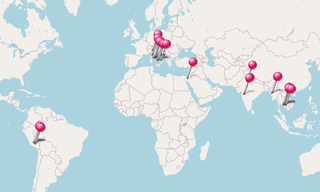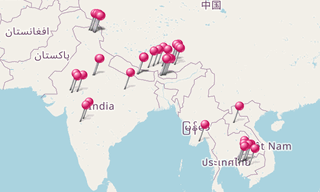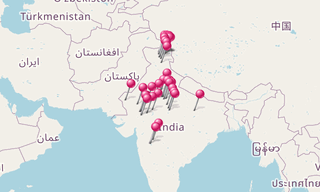Ellora is an archaeological site, 30 km from the city of Aurangabad in the Indian state of Maharashtra built by the Rashtrakuta rulers. Well-known for its monumental caves, Ellora is a UNESCO World Heritage Site. Ellora represents the epitome of Indian rock-cut architecture.
The 34 caves - actually structures excavated out of the vertical face of the Charanandri hills - being Buddhist, Hindu and Jain rock cut temples and monasteries, were built between the 5th century and 10th century. The 12 Buddhist (caves 1-12), 17 Hindu (caves 13-29) and 5 Jain (caves 30-34) caves, built in proximity, demonstrate the religious harmony prevalent during this period of Indian history.
The Buddhist monuments: Caves 1–12
These caves are located on the southern side and were built either between 600 – 730 CE. The earliest Buddhist cave is cave 6, then 5, 2, 3, 5 (right wing), 4, 7, 8, 10 and 9, with caves 11 and 12, also known as Do Thal and Tin Thal respectively, being the last.
Eleven out of the twelve Buddhist caves consist of viharas, or monasteries with prayer halls: large, multi-storeyed buildings carved into the mountain face, including living quarters, sleeping quarters, kitchens, and other rooms. The monastery caves have shrines including carvings of Gautama Buddha, bodhisattvas and saints.
In some of these caves, sculptors have endeavoured to give the stone the look of wood. Caves 5, 10, 11 and 12 are architecturally important Buddhist caves. Cave 5 is unique among the Ellora caves as it was designed as a hall with a pair of parallel refectory benches in the centre and a Buddha statue in the rear.
The Hindu monuments: Caves 13–29
The Hindu caves were constructed during the Kalachuris period, from the mid-6th century to the end of the 8th century in two phases. Nine cave temples were excavated early in the 6th century, followed by a further four caves (caves 17–29). Work first commenced, in order, on caves 28, 27 and 19 then caves 29 and 21, which were excavated concurrently with caves 20 and 26. Caves 17 and 28 were the last ones to be started.
The later caves, 14, 15 and 16, were constructed during the Rashtrakuta period, some being dated to between the 8th to 10th centuries. Work first began in caves 14 and 15 with cave 16, the world’s largest monolith, being the last of the three to be constructed.
These caves were completed in the 8th century with the support of king Krishna I.
The Jain monuments: Caves 30–34
At the north end of Ellora are the five Jain caves belonging to the Digambara sect, which were excavated in the 9th and 10th centuries. These caves are smaller than the Buddhist and Hindu caves but nonetheless feature highly detailed carvings. They, and the later-era Hindu caves, were built at a similar time and both share architectural and devotional ideas such as a pillared veranda, symmetric mandapa and puja (worship). Particularly important Jain shrines are the Chhota Kailash (cave 30, 4 excavations), the Indra Sabha (cave 32, 13 excavations) and the Jagannath Sabha (cave 33, 4 excavations); cave 31 is an unfinished four-pillared hall, and shrine.

-Cave-16-(Kailasa-Temple).hero.landscape.jpg?w=1600)

-Cave-32-(Jain-Tempel).jpg?w=256)
-Cave-10-(Chaitya-Vishvakarma).jpg?w=256)
-Cave-16-(Kailasa-Temple).jpg?w=256)
-Cave-16-(Kailasa-Temple).jpg?w=256)
-Cave-16-(Kailasa-Temple).jpg?w=256)
-Cave-16-(Kailasa-Temple).jpg?w=256)
-Cave-29-(Marriage-of-Shiva-Parvati).jpg?w=256)
-Cave-16-(Kailasa-Temple).jpg?w=256)
-Cave-32-(Indra-Sabha).jpg?w=256)
-Cave-16-(Kailasa-Temple).jpg?w=256)
.jpg?w=256)
.jpg?w=256)
-Cave-29.jpg?w=256)
-Cave-32-(Indra-Sabha-Siddhalka-Devi).jpg?w=256)
-Cave-10-(Chaitya-Vishvakarma).jpg?w=256)
-Cave-32-(Indra-Sabha).jpg?w=256)
-Cave-16-(Kailasa-Temple).jpg?w=256)
-Cave-8.jpg?w=256)
-Cave-16-(Kailasa-Temple).jpg?w=256)
-Cave-16-(Kailasa-Temple).jpg?w=256)
-Cave-5.jpg?w=256)
-Cave-16-(Kailasa-Temple).jpg?w=256)
-Cave-10-(Chaitya-Vishvakarma).jpg?w=256)
-Cave-32-(Indra-Sabha).jpg?w=256)
-Cave-32-(Indra-Sabha).jpg?w=256)
-Cave-32-(Indra-Sabha).jpg?w=256)
-Cave-16-(Kailasa-Temple).jpg?w=256)
-Cave-16-(Kailasa-Temple).jpg?w=256)
-Cave-16-(Kailasa-Temple).jpg?w=256)
-Cave-32.jpg?w=256)
-Cave-16-(Kailasa-Temple).jpg?w=256)
-Cave-16-(Kailasa-Temple).jpg?w=256)
-Cave-16-(Kailasa-Temple).jpg?w=256)
-Cave-29-(Yamuna).jpg?w=256)
-Cave-32-(Jain-Tempel).jpg?w=256)
.jpg?w=256)
-Cave-32-(Indra-Sabha).jpg?w=256)
-Cave-16-(Kailasa-Temple).jpg?w=256)
-Cave-32-(Indra-Sabha).jpg?w=256)
-Cave-32-(Indra-Sabha).jpg?w=256)
-Cave-16-(Kailasa-Temple).jpg?w=256)
-Cave-16-(Kailasa-Temple).jpg?w=256)
-Cave-29.jpg?w=256)
-Cave-16-(Kailasa-Temple).jpg?w=256)
-Cave-16-(Kailasa-Temple).jpg?w=256)
.jpg?w=256)
.jpg?w=256)
-Cave-16-(Kailasa-Temple).jpg?w=256)
-Cave-16-(Kailasa-Temple).jpg?w=256)
-Cave-32-(Jain-Tempel).jpg?w=256)
-Cave-16-(Kailasa-Temple).jpg?w=256)
-Cave-32-(Indra-Sabha).jpg?w=256)
-Cave-32-(Indra-Sabha-Bhagwan-Mahavir).jpg?w=256)
-Cave-16-(Kailasa-Temple).jpg?w=256)
-Cave-16-(Gajalaxmi).jpg?w=256)
.jpg?w=256)
-Cave-16-(Kailasa-Temple).jpg?w=256)
-Cave-10-(Chaitya-Vishvakarma).jpg?w=256)
-Cave-8.jpg?w=256)
-Cave-16-(Kailasa-Temple).jpg?w=256)
-Cave-32-(Parshwanath).jpg?w=256)
-Cave-16-(Kailasa-Temple).jpg?w=256)
-Cave-32-(Indra-Sabha-Matang-Yaksha).jpg?w=256)
-Cave-16-(Kailasa-Temple).jpg?w=256)
-Cave-16-(Kailasa-Temple).jpg?w=256)
-Cave-14-(Ravan-Ki-Khai).jpg?w=256)
-Cave-16-(Kailasa-Temple).jpg?w=256)
-Cave-16-(Kailasa-Temple).jpg?w=256)
-Cave-16-(Kailasa-Temple).jpg?w=256)
-Cave-16-(Kailasa-Temple).jpg?w=256)
-Cave-16-(Kailasa-Temple).jpg?w=256)
-Cave-16-(Kailasa-Temple).jpg?w=256)
-Cave-10-(Chaitya-Vishvakarma).jpg?w=256)
-Cave-16-(Kailasa-Temple).jpg?w=256)
-Cave-16-(Kailasa-Temple).jpg?w=256)
-Cave-16-(Kailasa-Temple).jpg?w=256)
-Cave-16-(Kailasa-Temple).jpg?w=256)
-Cave-16-(Kailasa-Temple).jpg?w=256)
-Cave-32-(Indra-Sabha).jpg?w=256)
-Cave-16-(Kailasa-Temple).jpg?w=256)
-Cave-16-(Kailasa-Temple).jpg?w=256)
-Cave-16-(Kailasa-Temple).jpg?w=256)
-Cave-32-(Indra-Sabha).jpg?w=256)
-Cave-16-(Kailasa-Temple).jpg?w=256)
-Cave-10-(Chaitya-Vishvakarma).jpg?w=256)
-Cave-16-(Kailasa-Temple).jpg?w=256)
-Cave-16-(Kailasa-Temple).jpg?w=256)
-Cave-16-(Kailasa-Temple).jpg?w=256)
-Cave-16-(Kailasa-Temple).jpg?w=256)
-Cave-16-(Kailasa-Temple).jpg?w=256)
-Cave-32-(Indra-Sabha).jpg?w=256)
.jpg?w=256)
-Cave-8.jpg?w=256)
-Cave-16-(Kailasa-Temple).jpg?w=256)
-Cave-16-(Kailasa-Temple).jpg?w=256)
-Cave-14-(Ravan-Ki-Khai).jpg?w=256)
-Cave-16-(Kailasa-Temple).jpg?w=256)
-Cave-16-(Kailasa-Temple).jpg?w=256)
-Cave-16-(Kailasa-Temple).jpg?w=256)
-Cave-16-(Kailasa-Temple).jpg?w=256)
-Cave-10-(Chaitya-Vishvakarma).jpg?w=256)
-Cave-16-(Kailasa-Temple).jpg?w=256)
-Cave-16-(Kailasa-Temple).jpg?w=256)
-Cave-16-(Kailasa-Temple).jpg?w=256)
-Cave-14-(Ravan-Ki-Khai).jpg?w=256)
-Cave-16-(Kailasa-Temple).jpg?w=256)
-Cave-16-(Kailasa-Temple).jpg?w=256)
-Cave-16-(Kailasa-Temple).jpg?w=256)
-Cave-21.jpg?w=256)
-Cave-32-(Indra-Sabha).jpg?w=256)
-Cave-16-(Kailasa-Temple).jpg?w=256)
-Cave-12-(Vihara).jpg?w=256)
-Cave-16-(Kailasa-Temple).jpg?w=256)
-Cave-16-(Kailasa-Temple).jpg?w=256)
-Cave-16-(Kailasa-Temple).jpg?w=256)
-Cave-16-(Kailasa-Temple).jpg?w=256)
-Cave-16-(Kailasa-Temple).jpg?w=256)
-Cave-16-(Kailasa-Temple).jpg?w=256)
.hero.jpg?w=320)

-Cave-19-(Chaitya-Griha).hero.jpg?w=320)

.hero.jpg?w=320)

.hero.jpg?w=320)
.map.png)